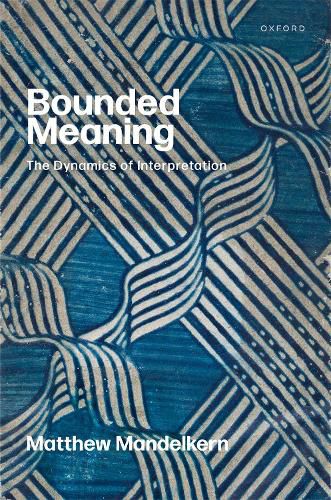Readings Newsletter
Become a Readings Member to make your shopping experience even easier.
Sign in or sign up for free!
You’re not far away from qualifying for FREE standard shipping within Australia
You’ve qualified for FREE standard shipping within Australia
The cart is loading…






Bounded Meaning investigates the dynamics of interpretation: how and why the interpretation of the building blocks of human language is sensitive, not just to the context in which the expression is used, but also to the expression's linguistic environmentDLin other words, how and why interpretation depends not just on global information, but also on local information. Matthew Mandelkern motivates a range of generalizations about the dynamics of interpretation, some known and some novel, involving modals, conditionals, and anaphora, and an overview of the best extant theory of those patterns, dynamic semantics, is provided. After bringing out the striking motivations and successes of that framework, the discussion turns to criticisms of dynamic semantics, focusing on its puzzling predictions about the logic of natural language. In response to these problems, Mandelkern develops a novel framework for explaining dynamic phenomena without dynamic semantics: the bounded theory of meaning. On the bounded theory, dynamic phenomena arise from the interaction of two dimensions of meaning. One dimension is a standard truth-conditional layer, which, relative to a context of use, associates each sentence with a proposition. The second dimension, the dimension of bounds, limits the admissible interpretations of an expression, relative to the expression's context of use and its local information. Bounds thus play an essential role in coordinating on the resolution of context-sensitive language, explaining dynamic effects in natural language while avoiding a variety of problematic predictions of dynamic semantics.
$9.00 standard shipping within Australia
FREE standard shipping within Australia for orders over $100.00
Express & International shipping calculated at checkout
Bounded Meaning investigates the dynamics of interpretation: how and why the interpretation of the building blocks of human language is sensitive, not just to the context in which the expression is used, but also to the expression's linguistic environmentDLin other words, how and why interpretation depends not just on global information, but also on local information. Matthew Mandelkern motivates a range of generalizations about the dynamics of interpretation, some known and some novel, involving modals, conditionals, and anaphora, and an overview of the best extant theory of those patterns, dynamic semantics, is provided. After bringing out the striking motivations and successes of that framework, the discussion turns to criticisms of dynamic semantics, focusing on its puzzling predictions about the logic of natural language. In response to these problems, Mandelkern develops a novel framework for explaining dynamic phenomena without dynamic semantics: the bounded theory of meaning. On the bounded theory, dynamic phenomena arise from the interaction of two dimensions of meaning. One dimension is a standard truth-conditional layer, which, relative to a context of use, associates each sentence with a proposition. The second dimension, the dimension of bounds, limits the admissible interpretations of an expression, relative to the expression's context of use and its local information. Bounds thus play an essential role in coordinating on the resolution of context-sensitive language, explaining dynamic effects in natural language while avoiding a variety of problematic predictions of dynamic semantics.